Abstract
Biological management techniques act as a promising and sustainable alternative to alleviate pathogen-induced losses, improve ecosystem functions, and reinforce the resilience of agricultural systems. Lebanese squash production has been threatened by powdery mildew disease caused by the fungus Podosphaera xanthii. Very few studies, even unpublished ones, stress the evaluation of biological control approaches in the Lebanese agriculture sector. Here, we have aimed to evaluate the effect of five safe biological treatments (olive soap, sodium bicarbonate, garlic extract, horsetail, and compost tea) in the management of powdery mildew on Lebanese squash in organic open field conditions. Plants were treated after the first spots of powdery mildew appeared on leaves. We then examined the leaves to evaluate disease incidence and severity, and to compare the ability of the five treatments to reduce powdery mildew disease and incidence, in comparison with the untreated control. Plants treated with sodium bicarbonate and garlic extract were the least affected by powdery mildew regarding disease incidence and severity, while tea compost proved to be the least effective product. Organic management of vegetable crops is extremely important in order to ensure global food security and reduce pesticide applications.
1. Introduction
In the 21st century, climate change has been a crucial challenge favoring biological invasion and threatening social and ecological development worldwide [1]. Human activities over the past 50 years have led to extreme and unpredictable variations in weather patterns such as temperature and rainfall levels. The average global temperature is rising by almost 0.8 °C per year, and is expected to increase further to reach an approximate value between 0.9 and 3.5 °C by 2100 [2]. According to the consensus of climate models, the Eastern Mediterranean region, including Lebanon, will warm at a rapid rate, which can raise the global temperature average by 1.3 to 2.7 °C and favor plant diseases [3,4]. In addition, annual precipitation levels will decrease by approximately 10 to 20% by the 2050s [5]. There has also been a dramatic increase in the concentration of greenhouse gases (GHG) in the atmosphere [6], particularly of atmospheric CO2, which has increased by almost 30% in the last few decades [7]. In general, agriculture is vulnerable because it is greatly influenced by climatic variations [8] and subject to crop pests and diseases [5,9]. However, this sector is itself considered a potential contributor to climate change, because it accounts for 24 to 30% of global GHG emissions [10,11,12].
Almost 40 to 50% of the global food supply is actually lost through crop pests and diseases. In terms of climate change, extreme temperatures and rainfall variations are significant factors that decisively control the distribution of ectotherm organisms and the survival of pests and pathogens. Precipitation variations can have major effects on crop–pathogen interactions because plant pathogens are favored by warm conditions and flourish under humid conditions [13]. Global warming also enhances the overwintering, development, and dispersal potential of pests and pathogens, which ultimately results in extreme disease severity, causing huge yield losses [14].
Accordingly, the proliferations of disease pressure and pest populations under high temperatures have led to the over-use of fungicides and insecticides in pest management techniques (i.e. higher amounts, doses, and frequencies than those recommended), so that pests and fungi have developed resistance to these agrochemicals. Further, the rise in temperature can also reduce the efficacy of particular pesticides. For instance, the toxic effects of bifenthrin and lambda-cyhalothrin (pyrethroids) and of spinosad (spinosyn) declined as the post-exposure temperature rose in [13].
Powdery mildew is a serious fungal disease worldwide, attacking Cucurbitaceae such as melon and zucchini. On the latter, it is caused by Podosphaera xanthii, previously known as Sphaerotheca fuliginea and Sphaerotheca fusca [15]. This disease is a considerable problem in Mediterranean countries, where it causes severe losses of crops grown in open fields and in greenhouses. The disease is generally controlled in commercial cucurbit crops via frequent applications of fungicides; however, heavy fungicide application has led to the development of resistant Podosphaera xanthii populations that can no longer be controlled by fungicides [16], and has also raised public concerns about contamination of the ecosystem. Therefore, there is great interest in the development of organic control strategies (using natural extracts or mixtures) that stimulate host plant defense mechanisms with the aim of mitigating and enhancing plant resilience to climate change [17,18] in a sustainable way [19]. For instance, the antimicrobial allicin, extracted from garlic (Allium sativum), is extremely active against a broad range of phytopathogenic organisms in vitro and in planta [20]. Successful trials and experiments using garlic sprays containing allicin confirm its effectiveness in treating plant diseases [21]. In addition, the bioactive element silicon (Si) contained in horsetail, (Equisetum arvense L.), reduces the toxic effect of water excess on plants that stimulates fungal disease development, and Equisetum arvense decoction exhibits highly effective anti-sporulation activity [22]. Moreover, compost tea, as described in various studies, has been efficient in controlling leaf diseases caused by powdery mildew, with a similar effect on conventional fungicides [23]. Furthermore, the bicarbonates widely used in the food industry [24] have been assessed for their ability to control plant pathogens. Sodium, potassium, and ammonium bicarbonates have been found to suppress several fungal diseases, particularly in greenhouse-grown cucumbers [25]. Mixed with any botanical extract, olive soap is usually used as wetting agent to facilitate the dispersion and penetration of each water-based treatment. As such, the latter is more effective and less sensitive to leaching. Therefore, this study investigates the effectiveness, under open-field conditions, of various natural products, including garlic extracts; horsetail extracts; aerated compost tea; olive soap (mixed with these natural products and used alone to elicit its potential fungal effect on the studied biotic stress); and sodium bicarbonate, as promising and sustainable treatments for powdery mildew in Lebanese squash within organic agriculture (OA) systems. According to the Research Institute of Organic Agriculture (www.fibl.com access on 10 November 2021), the average organic area in Lebanon is estimated to be close to 1300 ha for a period of 5 years (2015–2019), while the average organic area of vegetables fruits is around 20 ha over all of the country for the same period. According to the Lebanese Ministry of Agriculture (http://www.agriculture.gov.lb access on 30 December 2021), squash constitute the third vegetable–fruit crop (14.20%), after tomatoes and cucumbers, in terms of cultivated area in 2009 (there is a lack of available, updated and reliable agricultural statistics, which are still needed in the country). This study has practical implications and supports Lebanese farmers for appropriate and efficient organic control strategies of pathogens, and could prompt them to rely on their traditional skills and knowledge to control pests and diseases (i.e., preparation of botanical extracts), while enhancing the resilience and adaptation of OA systems to climate change. Furthermore, the added value of the present research is that it enriches the scientific literature on sustainable agriculture, which is particularly required by Lebanese local growers and the scientific community. Organic control strategies should be further encouraged in this country suffering the effects of climate change as it aims to preserve soil fertility, biodiversity, and ecosystem functions.
2. Material and Methods
2.1. Field Experiment Conditions
The experiment was carried out at the Kleïaat-Keserwan (LARI-K) station of the Lebanese Agricultural Research Institute (33.97 N, 35.71 E), where the climate is characterized by cold snowy winters and cool humid summers. The field plot was organic-certified (Supplementary Files S1 and S2), and was protected by Cypressus trees, on two boundaries, that serve as a buffer zone (Figure 1 and Figure 2). The experiment took place on around an area of 150 m2. The weather station at LARI-K recorded the climatic data throughout the 2 months of the experiment. The average minimum and maximum temperatures measured were 17.28 °C and 25.25 °C, respectively. The average minimum and maximum humidity levels were 61.49% and 84.85%, respectively. The recorded solar radiation was, on average, 271.86 W/m2. Consequently, the correspondent humidity and temperature levels favored the development of powdery mildew [26].
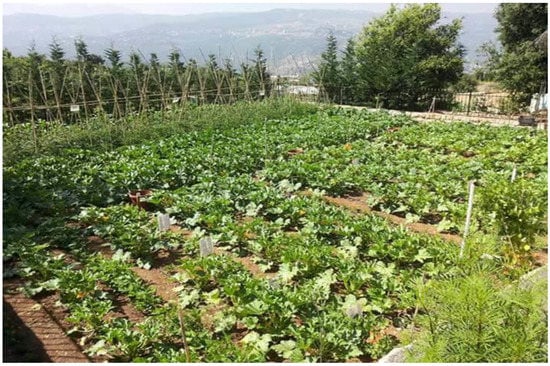
Figure 1.
An overview of the experimental field.
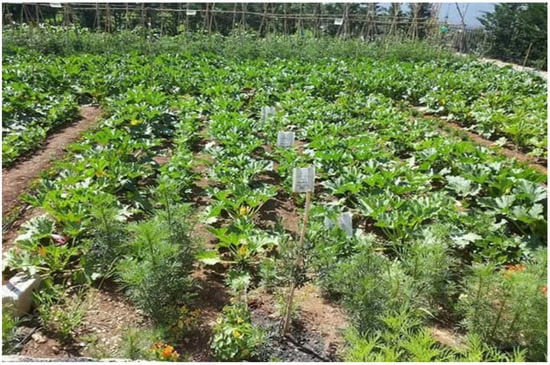
Figure 2.
A close-up of the experimental field.
Prior to planting, soil testing revealed a sandy clay loam texture without any mineral deficiency, thus, providing optimum conditions for zucchini growth and development. According to the climatic conditions, the irrigation process was scheduled every 2 to 3 days, using perforated pipes every 40 cm. In addition, compost tea was used here as an organic amendment and applied during one of every 2 irrigation water applications. The crops were not treated chemically because LARI-K is intended only for organic farming. The experiment began on 17 May 2018 and continued until 31 July 2018, when spot counting was performed. The climatic data were recorded constantly by the LARI-K weather station.
2.2. Field Experiment Treatments
Organic olive soap (Treatment A): Two hundred grams (200 g) of organic olive soap were finely chopped and dissolved in 2 L of water, then added to 8 L of water at the pulverization stage.
Sodium bicarbonate mixed with organic olive soap (Treatment B): One hundred grams (100 g) of sodium bicarbonate powder (Oxy Med) were weighed and mixed with 8 L of potable water. Then, 2 L of water with 200 g of organic olive soap was added to the mixture to spray directly on plants.
Organic garlic extract mixed with organic olive soap (Treatment C): One kilogram of dry organic garlic (Allium sativum) was peeled, and then chopped using an electric mixer. Subsequently, it was added to a container containing 8 L of potable water. The mixture was warmed over a low heat for 5 min, and then cooled to room temperature for about 10 min in order to be filtered in the sprayer. Lastly, 2 L of water with 200 g of organic olive soap was added to the mixture to spray directly on plants.
Natural horsetail plants mixed with organic olive soap (Treatment D): Two hundred and fifty grams (250 g) of dry horsetail (Equisetum arvense) from the shores of a lake near LARI-K were washed and cut into small pieces, then added to a container containing 8 L of drinking water. The mixture was warmed over a low heat for almost 30 min, then left to cool for 12 h at room temperature. After this, the mixture was drained using a filter to obtain a concentrated solution of horsetail, and 5 L of this solution was added to 3 L of potable water. Lastly, 2 L of water with 200 g of organic olive soap was added to the mixture to spray directly on plants.
Organic compost tea mixed with organic carob molasses (Treatment E): Fifty liters (50 L) of potable water, 2 kg of organic fertilizer (certified organic chicken manure from southern England), and 250 mL of organic carob molasses were mixed in a container and oxygenated for half an hour using an active oxygen pump. The container remained completely covered for 24 hours before spraying. This fermented liquid contained both soluble nutrients and living microorganisms. Lastly, 1 L of the final solution was poured into 9 L of potable water to form a solution for direct spraying onto plants.
2.3. Experimental Setup
In this experiment, ninety squash plants (Cucurbita pepo) of the cv Julienne, a variety with extremely small fruits, were planted in three blocks according to the randomized complete block design (RCBD), where three replications of each treatment applied were performed. The six treatments, as prepared and described above, were divided into 3 blocks (Figure 3). Each treated section comprised five squash plants sprayed for the first time (i.e., when the first white powdery spots appeared) on 3 July 2018, then once a week on 10, 17, and 24 July 2018.
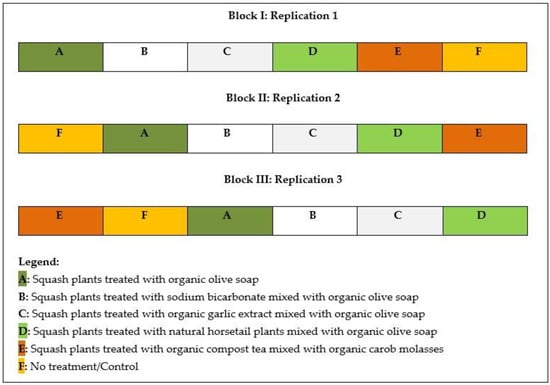
Figure 3.
Randomized complete block design.
2.4. Disease Evaluation
Three plants per treatment were randomly selected during the fourth week after the appearance of the first spots on the leaves and were examined to determine the disease incidence and the disease severity. Disease incidence was calculated as the percentage of infected plants, whereas disease severity was assessed by rating the symptoms of the leaves according to an empirical scale covering 8 categories, from 0 (sound leaves) to 7 (more than 75 percent of the leaf area affected by the pathogen). The scale values were used to compute the infection index [27], expressing the weighted average of the disease severity as a percentage of the possible maximum level of disease (100%). Therefore, for each treatment, the disease severity (DS) and its incidence (DI), expressed in %, were calculated [27] according to the equations, as presented in the Supplementary File S3 (see in the Supplementary Materials). Furthermore, a comparison between the efficacy of the treatments implemented (A, B, C, D and E) and the control treatment (F), based on the reduction in severity and incidence of powdery mildew on squash plants, was performed throughout this research study. The reduction percentage of powdery mildew disease severity and incidence as compared to the untreated control were calculated, as reported in the Supplementary File S3 [26].
2.5. Statistical Analysis
The data were subjected to the two-way analysis of variance, and when significant, the means were compared to 5% using Tukey’s test. In addition, IBM SPSS statistics software (version 23, 2018) was used for all statistical analyses.
3. Results
3.1. Effects of Treatments on Disease Incidence and Disease Severity
The incidence and severity of the powdery mildew varied between the different treatments, ranging from small powdery white spots on some leaves of the plant, to severe infection of most squash plants. Among all the different organic treatments, the analysis of variance demonstrated a significant statistical difference between the means of the disease incidence, and a very high significance among the means of the disease severity.
Regarding the disease incidence, the post hoc Tukey’s Honest Significant Difference (HSD) test divided the population of treatments into three homogenous subsets (Figure 4). Therefore, the plants treated with sodium bicarbonate (Treatment B) were the least affected, whereas the non-treated plants were the most affected by the attack of the powdery mildew, based on disease incidence.
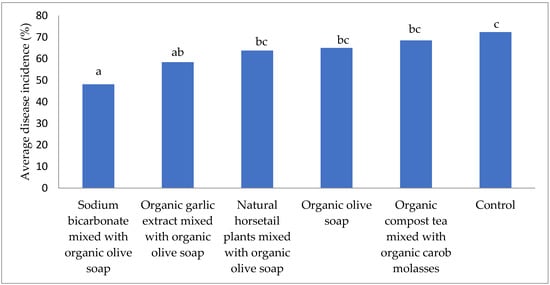
Figure 4.
Incidence of powdery mildew on squash plants of the cv Julienne. Values marked with the same letters (a, ab, bc, c) are not statistically different, according to the Tukey‘s HSD test (p ≤ 0.05).
Concerning disease severity (Figure 5), the post hoc Tukey’s HSD test also showed that the sodium bicarbonate mixed with organic olive soap was able to effectively control the powdery disease on squash. There was no statistical difference between the sodium bicarbonate mixed with organic olive oil or the organic garlic extract mixed with organic olive soap (p = 0.47), nor between the others treatments and the control (p = 0.19). Thus, the plants treated with sodium bicarbonate (Treatment B) and garlic extract (Treatment C) were the least affected by powdery mildew infection based on disease severity.
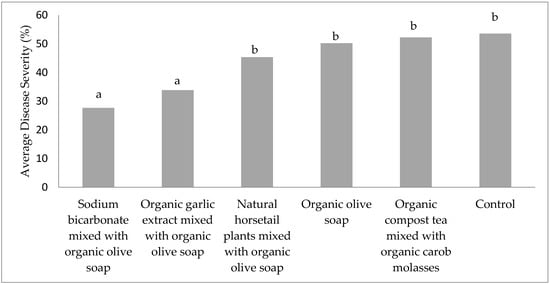
Figure 5.
Severity of powdery mildew on squash plants of the cv Julienne. Values marked with the same letters (a, b) are not statistically different, according to the Tukey‘s HSD test (p ≤ 0.05).
3.2. Effects of Treatments on the Reduction in Disease Incidence and Disease Severity
Figure 6 and Figure 7 show the distribution of the various organic treatments according to their effectiveness in terms of the reduction in disease incidence and disease severity, compared to the untreated control, in the management of powdery disease on squash. Among all treatments, sodium bicarbonate mixed with organic olive soap was the most effective treatment in protecting squash plants, with a reduction in powdery mildew incidence and severity. The garlic extract mixed with organic olive soap resulted as the second most effective treatment. Furthermore, the natural horsetail extract mixed with organic olive soap, the organic olive soap, and the organic compost tea mixed with organic carob molasses are classified as the third, fourth, and fifth most effective treatments, respectively.
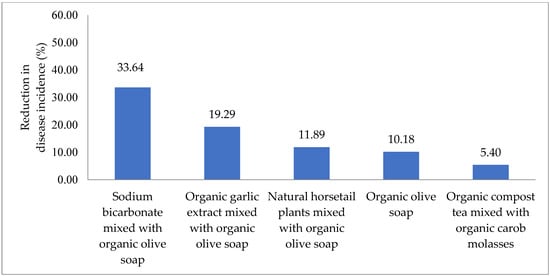
Figure 6.
Reduction in powdery mildew incidence on Lebanese squash, cv Julienne, as affected by the different organic treatments.
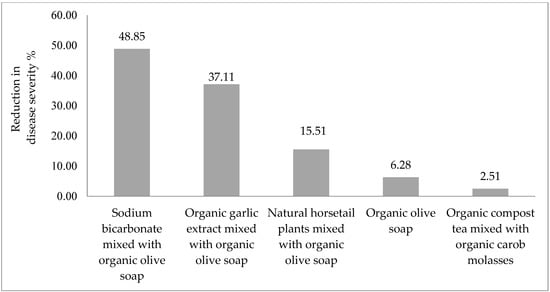
Figure 7.
Reduction in powdery mildew disease severity on Lebanese squash, cv Julienne, as affected by the different organic treatments.
4. Discussion
Pests and pathogens thrive and proliferate during long growing seasons in warm climates [28]. Fungal diseases, particularly powdery mildew, are among the most important factors limiting squash yield and causing serious economic losses. Consequently, large farmers tend to rely on extensive fungicide applications to limit this fungal infection and minimize their crop losses; however, this involves emissions of harmful gases that further aggravate climate change, environmental pollution, and human health problems. This challenging issue should prompt scientists to develop modern, sustainable and efficient biological products with low environmental toxicity for use against pests and pathogens, and to encourage their adoption by farmers, in order to enhance food quality and protect natural resources and the ecosystem.
In this experimental study, sodium bicarbonate was found to be a successful and sustainable biological alternative that can protect squash crops from powdery mildew infection. The use of this product in the initial stages of disease, when the first whitish spots appear, damages the cell wall membrane of the fungal spores, causing them to dry out and inducing necrosis [29]. Subsequently, the death of Sphaerotheca fuliginea (Sf) spores inhibited the spread of infection, and thus, resulted in low values of disease severity (27.43%) and incidence (48.04%). Our results are in line with other similar studies [30,31]. The first of these [30] applied various polymers and an aqueous solution of sodium or potassium bicarbonate to control powdery mildew on cucurbits. Their results demonstrated that sodium bicarbonate was the most effective treatment and stopped any Sf infection in plants. In addition, the second study [31] observed that sodium bicarbonate limited the development of powdery mildew on Craterostigma pumilum by 71.42%. Another study evaluated the effect of two different treatments used to control powdery mildew disease in cucurbits: monopotassium phosphate and potassium nitrate. The results demonstrated that additional foliar sprays of sodium bicarbonate (1%) had a considerable effect on suppressing powdery mildew colonies on infected foliage [29,32].
Furthermore, allicin from garlic extract is known for its effective antifungal activity [19], and in this study, the garlic extract actively inhibited powdery mildew spore development and spread, thus limiting disease development. The effectiveness of allicin has been also demonstrated by Seo, who found that garlic extract reduced Sf on cucumbers by 74% when studied in vivo [33].
On the other hand, horsetail extract delayed the development of powdery mildew symptoms on plants, but without completely stopping disease development. In fact, Sf was able to resist the effect of horsetail silica, which induces the formation of physical and chemical barriers [34]. However, these results differ from those of Bélanger et al. [6], who reported horsetail extract as providing a complete and effective protection for cucumber plants against Sf infection.
The powdery mildew disease incidence and severity in the experiment conducted at LARI-K were 50% and 65%, respectively, when the squash plants were treated with organic olive soap. These results do not correspond to those obtained by Muhanna et al. [35]. The latter revealed that potassium-based products induce systemic resistance in squash plants against powdery mildew, and thereby reduce the severity of the disease. This discrepancy can be explained by the fact that organic olive soap must be applied before the plants become infected by powdery mildew in order to act effectively [16], whereas organic olive soap was applied after the onset of the first symptoms during our experimental procedure.
The efficacy of the compost tea was very limited. This limitation matches the results reported by De Bacco [36] when assessing the effect of compost tea on Podosphaera xanthii of pumpkin [36]. Certainly, the adoption of biological products to control powdery mildew disease would reduce management costs for farmers. With the exception of sodium bicarbonate (10 US$/Kg), the largest relative reduction in production costs could be obtained by using garlic extract mixed with olive soap (3 US$/Kg). However, this study does not evaluate these products in terms of per-hectare yield, overall cost estimates per cropping system, or farm returns. Ultimately, extension services, scientists, governmental organizations, and public- and private-sector stakeholders should coordinate their efforts in order to reinforce this biological approach to pest and disease management—thus reducing the reliance of agriculture on massive chemical inputs [26]—and also to control the evolving climate-change-induced diseases, as well as pest threats and invasions, sustainably and more efficiently.
5. Conclusions
In this study, the biological treatments contain active substances (i.e., allicin in garlic; silica in horsetail; potassium in olive soap) that can successfully control powdery mildew on squash plants. As sodium bicarbonate is alkaline (pH above 7), it inhibits and creates an unsuitable environment for the growth of the fungal pathogen. The results obtained in this study suggest that sodium bicarbonate can be a safe and effective organic bio-agent for the control of powdery mildew in squash plants.
The organic management of crop diseases, such as powdery mildew in squash, is extremely important in order to ensure global food security, to reduce pesticide applications and GHG emissions, to maintain sustainable production practices, and to minimize the vulnerability of farmers to the negative impacts of climate change [17,37]. It is imperative to recognize the importance of using biological alternatives to control crop pests and diseases without relying solely on chemicals; this is because the biological approach can help to sustain crop production and maintain farmers’ livelihoods, mitigating the impacts of global climate change.
Further research is needed in order to comprehensively assess the effectiveness of different concentrations of the different treatments used in this study and their effectiveness “in vitro”, and also to give greater recognition to the role of bio-agent compounds for their worldwide authentication and adaptation for use against plant diseases.
Supplementary Materials
The following supporting information can be downloaded at: https://www.mdpi.com/article/10.3390/su14052811/s1, Supplementary Material Files S1: LARI’s organic certificate (2017), Supplementary Material Files S2: LARI’s organic certificate (2019), Supplementary Material Files S3: Equations used for parameters evaluation.
Author Contributions
Conceptualization, M.F., F.N. and M.E.M.; methodology, M.F., F.N. and M.E.M.; software, M.F. and S.M.; validation, F.N. and M.E.M.; formal analysis, M.F. and F.N.; investigation, M.F. and S.M.; data curation, S.M.; writing—original draft preparation, M.F. and S.M.; writing—review and editing, M.F., F.N. and M.E.M.; visualization, S.M.; supervision, F.N. and M.E.M.; project administration, M.F. All authors have read and agreed to the published version of the manuscript.
Funding
This research received no external funding.
Institutional Review Board Statement
Not applicable.
Informed Consent Statement
Not applicable.
Data Availability Statement
Not applicable.
Acknowledgments
Thanks are due to Nidale El Hachem and Maroun Zgheib for helping with data collection, to Tracy Khalil for sourcing references and to Sarah Jane Christopher for translation.
Conflicts of Interest
The authors declare that there is no conflict of interest.
References
- Frem, M.; Santeramo, F.G.; Lamonaca, E.; El Moujabber, M.; Choueiri, E.; La Notte, P.; Nigro, F.; Bozzo, F.; Fucilli, V. Landscape restoration due to Xylella fastidiosa invasion in Italy: Assessing the hypothetical public’s preferences. NeoBiota 2021, 66, 31–54. [Google Scholar] [CrossRef]
- Das, T.; Majumdar, M.H.D.; Devi, R.T.; Rajesh, T. Climate change impacts on plant diseases. J. Agric. 2016, 14, 200–209. [Google Scholar] [CrossRef]
- Abou Kubaa, R.; Choueiri, E.; De Stradis, A.; Jreijiri, F.; Saponari, M.; Cillo, F. Occurrence and distribution of major viruses infecting eggplant in Lebanon and molecular characterization of a local potato virus X isolate. Agriculture 2021, 11, 126. [Google Scholar] [CrossRef]
- Choueiri, E.; Jreijiri, F.; Saponari, M.; Abou Kubaa, R. Tomato spotted wilt virus associated with lettuce dieback in Bekaa valley, Lebanon. J. Plant Pathol. 2021, 103, 387. [Google Scholar] [CrossRef]
- World Bank. The World Bank Annual Report 2013; World Bank: Washington, DC, USA, 2013; Available online: https://openknowledge.worldbank.org/handle/10986/16091 (accessed on 15 October 2021).
- Bélanger, R.; Bowen, P.A.; Ehret, D.L.; Menzies, J.G. Soluble silicon: Its role in crop and disease management of greenhouse crops. Plant Dis. 1995, 79, 329–336. [Google Scholar] [CrossRef]
- Chakraborty, S.; Datta, S. How will plant pathogens adapt to host plant resistance at elevated CO2 under a changing climate? New Phytol. 2013, 159, 733–742. [Google Scholar] [CrossRef] [PubMed]
- Reilly, J. Climate change and agriculture: Recent findings and issues. Am. J. Econ. 1995, 367, 118–119. [Google Scholar] [CrossRef]
- Gullino, M.L.; Tabone, G.; Gilardi, G.; Garibaldi, A. Effects of elevated atmospheric CO2 and temperature on the management of powdery mildew of zucchini. J. Phytopathol. 2020, 168, 405–415. [Google Scholar] [CrossRef]
- IPCC. Climate Change 2001: Synthesis Report. A Contribution of Working Groups I, II, and III to the Third Assessment Report of the Intergovernmental Panel on Climate Change (IPCC); Watson, R.T., The Core Writing Team, Eds.; Cambridge University Press: Cambridge, UK; New York, NY, USA, 2001; p. 398. [Google Scholar]
- IPCC. Managing the Risks of Extreme Events and Disasters to Advance Climate Change Adaptation. A Special Report of Working Groups I and II of the Intergovernmental Panel on Climate Change (IPCC); Field, C.B., Barros, V., Stocker, T.F., Qin, D., Dokken, D.J., Ebi, K.L., Mastrandrea, M.D., Mach, K.J., Plattner, G.-K., Allen, S.K., et al., Eds.; Cambridge University Press: Cambridge, UK; New York, NY, USA, 2012; p. 582. [Google Scholar]
- Gomiero, T.; Paoletti, M.G.; Pimentel, D. Energy and environmental issues in organic and conventional agriculture. CRC Crit. Rev. Plant Sci. 2008, 27, 239–254. [Google Scholar] [CrossRef]
- Heeb, L.; Jenner, E.; Cock, M.J.W. Climate-smart pest management: Building resilience of farms and landscapes to changing pest threats. J. Pest Sci. 2019, 92, 951–969. [Google Scholar] [CrossRef]
- Harvell, C.D.; Mitchell, C.E.; Ward, J.R.; Altizer, S.; Dobson, A.P.; Ostfeld, R.S. Climate warming and disease risks for terrestrial and marine biota. Science 2002, 296, 2158–2162. [Google Scholar] [CrossRef]
- Garibaldi, A.; Gilardi, G.; Gullino, M.L. First report of powdery mildew caused by Podosphaera xanthii on Calendula officinalis in Italy. Plant Dis. 2008, 92, 174. [Google Scholar] [CrossRef] [PubMed]
- McGrath, M.T.; Shishkoff, N. Evaluation of biocompatible products for managing cucurbit powdery mildew. J. Crop Prot. 1999, 18, 471–478. [Google Scholar] [CrossRef]
- El Chami, D. Towards sustainable organic farming systems. Sustainability 2020, 12, 9832. [Google Scholar] [CrossRef]
- Ntonifor, N.N. Potentials of tropical African spices as sources of reduced-risk pesticides. J. Entomol. 2011, 8, 16–26. [Google Scholar] [CrossRef][Green Version]
- Leontiev, R.; Hohaus, N.; Jacob, C.; Gruhlke, M.C.H.; Slusarenko, A.J. A comparison of the antibacterial and antifungal activities of thiosulfinate analogues of allicin. Sci. Rep. 2018, 8, 6763. [Google Scholar] [CrossRef]
- Curtis, H.; Noll, U.; Strmann, J.; Slusarenko, A.J. Broad-spectrum activity of the volatile phytoanticipin allicin in extracts of garlic (Allium sativum L.) against plant pathogenic bacteria, fungi and Oomycetes. Physiol. Mol. Plant Pathol. 2004, 65, 7989. [Google Scholar] [CrossRef]
- Russell, P.E.; Mussa, A.E.A. The use of garlic (Allium sativum) extracts to control foot rot of Phaseolus vulgaris caused by Fusarium Solani f. sp. phaseoli. Ann. Appl. Biol. 1977, 86, 369–372. [Google Scholar] [CrossRef]
- Marchand, P.A. Basic substances under EC 1107/2009 phytochemical regulation: Experience with nonbiocide and food products as biorationals. J. Plant Prot. Res. 2016, 56, 312–318. [Google Scholar] [CrossRef]
- Litterick, A.M.; Harrier, L.; Wallace, P.; Watson, C.A.; Wood, M. The role of uncomposted materials, composts, manures, and compost extracts in reducing pest and disease incidence and severity in sustainable temperate agricultural and horticultural crop production review. CRC Crit. Rev. Plant Sci. 2004, 23, 453–479. [Google Scholar] [CrossRef]
- Lindsay, R.C. Food additives. In Food Chemistry; Fennema, O.R., Ed.; Marcel Dekker, Inc.: New York, NY, USA, 1985; Chapter 10. [Google Scholar]
- Ziv, O.; Zitter, T.A. Effects of bicarbonates and film-forming polymers on cucurbit foliar diseases. Plant Dis. 1992, 76, 513–517. [Google Scholar] [CrossRef]
- Dik, A.J.; Verhaar, M.A.; Bélanger, R.R. Comparison of three biological control agents against cucumber powdery mildew (Sphaerotheca fuliginea) in semi-commercial-scale glasshouse trials. Eur. J. Plant Pathol. 1998, 104, 413–423. [Google Scholar] [CrossRef]
- Surhanee, A.M.A. Efficiency of the extracts of some plants on squash powdery mildew. Mediterr. J. Soc. Sci. 2013, 4, 39–49. [Google Scholar] [CrossRef]
- Frem, M.; Chapman, D.; Fucilli, V.; Choueiri, E.; Moujabber, M.E.; La Notte, P.L.; Nigro, F. Xylella fastidiosa invasion of new countries in Europe, the Middle East and North Africa: Ranking the potential exposure scenarios. NeoBiota 2020, 59, 77–97. [Google Scholar] [CrossRef]
- Lahoz, E.; Contillo, R.; Nicoletti, R.; Oliva, A. Efficacy of rue extracts sodium bicarbonate and fungicides at reduced rates for control of powdery mildew on tobacco. Atti Giornate Fitopatol. 2000, 122, 16–20. [Google Scholar]
- Ziv, O.; Hagiladi, A. Controlling powdery mildew in Euonymus with polymer coatings and bicarbonate solutions. Hortic. Sci. 1993, 28, 124–126. [Google Scholar] [CrossRef]
- Tammasorn, N.; Wanasiri, N.; Kuntasup, W.; Cheewangkoon, R.; McGovern, R.J.; ToAnun, C. Controlling powdery mildew disease of Craterostigma pumilum Hochst. Ornamental plant. J. Agric. Technol. 2017, 13, 213–226. [Google Scholar]
- Reuveni, M.; Agapov, V.; Reuveni, R. Controlling powdery mildew caused by Sphaeromeci Juliginea in cucumber by foliar sprays of phosphate and potassium salts. J. Crop Prot. 1996, 15, 49–53. [Google Scholar] [CrossRef]
- Seo, S.T.; Lee, J.S.; Park, J.H.; Han, K.S.; Jang, H.I. Control of powdery mildew by garlic oil in cucumber and tomato. Res. Plant Dis. 2006, 12, 51–54. [Google Scholar] [CrossRef]
- Pozza, E.A.; Pozza, A.A.A.; Botelho, D.M. Silicon in plant disease control. Rev. Ceres 2015, 62, 323–331. [Google Scholar] [CrossRef]
- Muhanna, N.A.S.; Raghab, S.S.M.; Mohamed, G.M. Mineral salts in controlling powdery mildew of squash. Egypt. J. Agric. Res. 2011, 89, 809–818. [Google Scholar] [CrossRef]
- DeBacco, M. Compost Tea and Milk to Suppress Powdery Mildew (Podosphaera xanthii) on Pumpkins and Evaluation of Horticultural Pots Made from Recyclable Fibers under Field Conditions. Master’s Thesis, University of Connecticut, Storrs, UK, 2011; p. 101. Available online: https://opencommons.uconn.edu/gs_theses/101 (accessed on 15 October 2021).
- El Chami, D.; Daccache, A.; El Moujabber, M. How can sustainable agriculture increase climate resilience? A systematic review. Sustainability 2020, 12, 3119. [Google Scholar] [CrossRef]
Publisher’s Note: MDPI stays neutral with regard to jurisdictional claims in published maps and institutional affiliations. |
© 2022 by the authors. Licensee MDPI, Basel, Switzerland. This article is an open access article distributed under the terms and conditions of the Creative Commons Attribution (CC BY) license (https://creativecommons.org/licenses/by/4.0/).